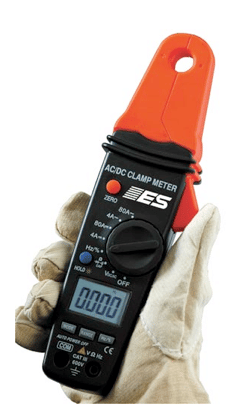
The ES Low Current Probe
Electrical problems are one of the most frequent situations that a boater faces, especially on boats subject to the corrosive effects of saltwater. Traditionally a voltmeter and ohmmeter were employed to measure to the circuit voltage and resistance. In some cases, an ammeter was needed to check the current flow or to see if there was a current draw when the motor was not running. Charging system tests were time consuming and care had to be taken to keep from shorting out connections with test equipment attached. Parasitic current draw often runs a charged battery down within a week and measuring voltage of each item took time.
The Electronic Specialties, Inc. produces the #687 Low Current Probe/DMM that makes finding electrical abnormalities very easy. It contains several meters in one plus it measure amps without disconnecting any wiring. Its clip-on design fits over a wire, senses the current flow, and displays it on an LCD screen. To check alternator charging, simply place the probe over a battery cable or the alternator wire and read the result.
If the battery runs down over time, again clip onto a cable and the #687 reads as low as 1 milliamp ( 0.001 amp ) to find the smallest current draw. For other electrical items such as electric fuel pumps, blowers, or power trim motors clamp the probe over a wire to check amperage use and then refer to the service specifications.
The ESI probe houses additional meters to help with electrical troubleshooting and you only need to carry this one tool instead of several with their resulting tangle of wires. The #687 probe contains a voltmeter, ohmmeter, ammeter, frequency meter, diode tester, and a capacitance meter. By turning the dial you select from one type of meter to another instantly to quickly test almost any type of electrical circuit.
The amp probe is not a cheap tool, it is of professional quality and sells online for about $125 from sources such as Amazon.com or tool supply houses. Though a DIY individual may not want to spend much for test equipment but a group of friends could go together on the purchase and share it. This single tool that takes the place of six different meters can save you money and time when trying to find that elusive electrical malfunction in a boat.
ALL YOUR DIY QUESTIONS ANSWERED ON BOATINGMAG.COM









